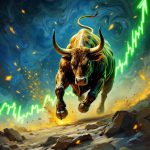Santa Claus Rally: Empty Hype or Real Momentum?
Feb 10, 2025
The financial markets are rarely immune to the influence of seasonal moods and collective sentiment—even during festivity and cheer. The phenomenon known as the *Santa Claus Rally* has long captivated investors with its promise of an end-of-year uplift, leaving many questioning: is it truly a market mover or merely an echo of misplaced exuberance? Today, we will examine the Santa Claus Rally in the context of recent market behaviour, analyzing its interplay with the January effect and exploring the complex dance between Mass Psychology, Technical Analysis, and Common Sense. Here, we will also consider whether the co-occurrence of these phenomena produces a synergistic effect that can reshape market outcomes—or if it simply releases a lot of hot air, providing a spectacle that is entertaining yet ultimately unsubstantial.
Unwrapping the Santa Claus Rally
As the holiday lights twinkle and carols fill the air every December, market watchers brace themselves for the so-called Santa Claus Rally. This period, typically spanning the final trading days of December and the first couple of days into January, is famed for generating unexpected gains. But what underlies this seasonal surge?
The Santa Claus Rally has historically been attributed to a cocktail of factors: a mix of end-of-year portfolio adjustments, tax-related manoeuvres, and an overall buoyant investor mood driven by the holidays. In 2024, for example, the rally was notably strong. Analysts observed that heightened optimism—fueled partly by breakthroughs in generative AI and pending policy moves such as interest rate cuts—ignited a surge in investor sentiment. Much like children awaiting Santa’s sleigh, there was a palpable sense of renewed possibility as market participants anticipated a gift of prosperity.
Yet beneath this festive veneer, the rally’s foundation is not always as robust as it seems. The allure of a seasonal upswing often masks underlying vulnerabilities. As the great investor Warren Buffett once advised, “Be fearful when others are greedy and greedy when others are fearful.” This timeless piece of wisdom reminds us that unbridled optimism can be as dangerous as it is enticing, particularly when it is disconnected from rigorous market realities.
Generative Optimism: Santa Claus Rally in 2024
The Santa Claus Rally in 2024 represented more than just a calendar anomaly; it manifested what could be described as generative optimism. Investors arrived at the market with a renewed sense of purpose, buoyed by positive expectations surrounding technical breakthroughs and favourable fiscal policies. The influence of advancements in generative AI, alongside the sustained buzz of anticipated interest rate cuts, provided a powerful narrative. This narrative, oscillating between technological promise and fiscal reprieve, gave credence to the rally, allowing it to muster its gains amidst an otherwise uncertain economic landscape.
In this instance, Mass Psychology played a pivotal role. The festive mood of the season works like a catalyst, transforming isolated positive news into a broader sentiment of unstoppable progress. The rally was not merely about data and technical indicators—it was about the contagious nature of hope and expectation. A palpable sense of holiday cheer spread through trading floors and online message boards, pushing prices upward in a self-reinforcing cycle of buying and bullish speculation.
Yet, as with many phenomena driven by human emotion, an inherent risk exists. The emotional fervour that fuels such rallies may also blind investors to underlying structural weaknesses. Indeed, while the Santa Claus Rally in 2024 delivered notable gains, one must question whether this was a sustainable development or simply a mirage—a seasonal anomaly brought to life by the transient power of collective sentiment.
The January Effect: A Cold Wake-Up Call in 2025
In stark contrast to the buoyant atmosphere of the Santa Claus Rally, the early days of 2025 have painted a more sombre picture. The January effect, a well-documented occurrence where markets typically adjust during the first month of the year, has taken on a decidedly negative hue. The January Barometer—a heuristic that suggests the performance of January can predict the tone of the remaining year—has, in 2025, signalled caution and a recalibration of investor expectations.
This downturn can be attributed to a shift in sentiment as investors confront the new economic data and policy updates that define the early months of the year. Where the holiday season is characterized by a sense of celebration and boundless optimism, January often brings a return to sober realities. The exuberance of December is replaced by a meticulous reassessment of economic fundamentals, risk exposures, and the cost of capital moving forward.
The divergence between the Santa Claus Rally’s effervescent gains and the January effect’s correction highlights a critical dynamic in market psychology. As John Maynard Keynes famously stated, “Markets can remain irrational longer than you can remain solvent.” The festive cheer of the previous year sets the stage for a dramatic contingency as new information forces the market to reassess its positions. Once swept away by the tidal force of holiday optimism, investors find themselves grappling with the cold, hard numbers of January’s economic data.
Synergy or Clash? When Santa Claus Rally Meets January Effect
A central question from this analysis is whether the Santa Claus Rally and the January effect, when occurring in concert, might produce a synergistic effect that amplifies market momentum or cancel each other out. In theory, one could argue that the cheerful optimism at year-end might carry over into January, providing a cushion that dampens the negative force typically associated with the new year. However, the evidence from the 2024 rally and the 2025 January performance suggests otherwise.
When these two effects occur together, the interplay can resemble a volatile tug-of-war. While the festive rally injects enthusiasm, its momentum is counterbalanced by a more sobering reassessment of market realities. In many respects, the combined effect is bittersweet—a brief spectacle of exuberance that ultimately gives way to a more measured and sometimes disappointing market correction.
In Mass Psychology, one might liken the combined phenomenon to the act of “releasing gas”: there is a lot of noise, visceral reaction, and plenty of spectacle that provides entertainment. Yet, despite the impressive show, the overall impact may be little more than a fleeting distraction. This analogy, while humorous, underscores an important point: relying solely on the seductive energy of seasonal sentiment—without the anchoring influence of Technical Analysis—leaves investors with little more than transient thrills. In other words, while the festive atmosphere can be entertaining, it is no substitute for technical analysis’s rigorous, data-driven insights.
Diving Deeper: Technical Analysis and Common Sense in Seasonal Markets
So, how does one navigate this labyrinth of seasonal optimism and subsequent market recalibration? The answer lies in integrating Technical Analysis, Common Sense, and insights gleaned from Mass Psychology. Technical Analysis provides a structured framework to assess historical price trends, chart patterns, and momentum indicators, counterbalancing the more unpredictable influences of human emotion.
Consider the Santa Claus Rally: while its allure is rooted in the contagious spirit of holiday cheer, technical analysis demands that we scrutinize the data with cold, objective rigour. Do sustainable trends support the gains, or are they merely ephemeral bursts of excitement? Similarly, the January effect should be dissected in terms of sentiment and through the lens of chart signals and market breadth metrics. Blending these methodologies—merging the art of understanding human behaviour with the science of market data—yields a more comprehensive view of seasonal market dynamics.
Those who rely exclusively on the festive fervour of seasonal hype may find themselves ill-equipped to handle the inevitable correction that follows. The elegance of technical analysis lies in its ability to cut through the noise, revealing patterns and trends obscured by the transient whims of market sentiment. Benjamin Franklin wisely noted, “An investment in knowledge pays the best interest.” In the context of seasonal market phenomena, this means understanding that while the Santa Claus Rally may inspire temporary buoyancy, the disciplined application of analytical tools ultimately drives long-term success.
Weighing the Evidence: Does the Synergistic Effect Hold Up?
Returning to the interplay between the Santa Claus Rally and the January effect, we must ask: does the synergy of these phenomena materially alter market dynamics? The answer appears to be complex. In some instances, the enthusiastic fuel from December’s rally may briefly counter January’s historical downturn. Yet, this interplay is often short-lived. As the market confronts new economic realities, the initial burst of optimism dissipates, giving way to sobering technical signals that caution against overextension.
Moreover, when evaluated through the lens of Mass Psychology in tandem with Technical Analysis, the purported synergy reveals its limitations. While isolated elements of each phenomenon may offer insights, their combined effect often resembles a high-profile spectacle that is visually compelling but ultimately hollow in substance. It is akin to watching an elaborate fireworks display: dazzling at the moment but fading rapidly into darkness, leaving behind only the residual memory of brilliance.
Thus, investors would do well to temper their excitement when these seasonal effects coincide. Rather than succumbing to the allure of widespread market euphoria, a more prudent approach involves synthesizing the available data with a healthy dose of scepticism and common sense. By doing so, one can discern when the market is genuinely on the cusp of a transformative move and when it is simply putting on a festive show.
The Role of Mass Psychology: Entertainment or Strategic Indicator?
Mass Psychology is a double-edged sword. On the one hand, it is a powerful catalyst that can propel market sentiment to euphoric heights—particularly in seasonal events like the Santa Claus Rally. The collective excitement during the holiday season is not merely anecdotal; it can translate into tangible, if ephemeral, market movements. Yet, critics argue that this same force can be little more than theatrical posturing—a bright spectacle that ultimately “releases gas,” generating a lot of stink with no enduring punch.
This colourful metaphor captures the essence of the issue. While the festive circus of market optimism can be captivating and entertaining, it often lacks the substance required to drive lasting financial results. In contrast, Mass Psychology, when paired with Technical Analysis, offers a more robust framework for decision-making. The objective insights derived from technical tools demystify the whims of collective sentiment, enabling investors to distinguish between transient hype and meaningful trends.
The Santa Claus Rally, for instance, may evoke images of holiday merriment and robust market gains, but without the keen eye of technical scrutiny, its promises risk appearing as nothing more than a seasonal mirage. Investors are thus advised to appreciate the spectacle for what it is—a moment of shared optimism—but to ground their strategies in the rigour of data analysis and the timeless wisdom of common-sense investing.
A Festive Dance Between Hype and Reality
Drawing the threads together, the seasonal phenomena of the Santa Claus Rally and the January effect present a fascinating study of the interplay between emotion and reason within the markets. The rally, rooted in fervent holiday optimism, embodies the transformative power of **Mass Psychology**—a force that can temporarily buoy markets with the promises of a brighter future. Yet, as the new year dawns with the stark reality of economic data and altered investor sentiment, the invigorating effects of the rally are often tempered by the more reflective and sometimes pessimistic January effect.
This juxtaposition serves as a reminder of the inherent cyclical nature of markets. While the exuberance of the Santa Claus Rally may momentarily lift spirits and stock prices, the underlying market dynamics, as revealed through technical analysis, often signal that such gains are not always sustainable. The measurable indicators of market performance—price trends, volume shifts, and broader economic metrics—tend to reassert themselves once the initial burst of holiday excitement subsides.
Conclusion: Embracing the Dual Nature of Seasonal Markets
The journey through the festive corridors of market behaviour reveals a complex interplay between adulation and apprehension, between renewed optimism and cautious recalibration. The Santa Claus Rally, with its magnetic draw of holiday cheer and technological promise, ignited a robust burst of enthusiasm in 2024—propelled by advancements in generative AI and anticipated policy shifts. Yet, the subsequent onset of the January effect 2025 served as a stark reminder of the market’s ability to swiftly realign with fiscal reality.
While some may argue that the co-occurrence of these phenomena might create a synergistic effect, the evidence suggests that their interaction is more akin to a dazzling but transient display of festive fireworks—spectacular at the moment, yet ultimately unsustainable without the rigorous underpinning of Technical Analysis. In Mass Psychology, these seasonal effects can sometimes be compared to releasing gas: a lot of stink, good for entertainment, but lacking the robust impact achieved when mass psychology is strategically merged with precise technical insights.
The ultimate takeaway for investors is the timeless value of a balanced approach. Embrace the euphoric energy of seasonal rallies, but always ground your decisions in the hard truths of data and market fundamentals. Fearless yet disciplined, bold yet rational—this is the recipe for navigating the festive highs and subsequent lows and the intricacies of market cycles in any season.
As we stand at the crossroads of holiday nostalgia and the sober realities of a new fiscal year, let us heed the wisdom of the ages: Common Sense, complemented by rigorous analytical tools, is the cornerstone of enduring financial success. The Santa Claus Rally may dazzle, and January may bring challenges. Still, those who blend the art of mass psychology with the science of technical analysis will always find a pathway through the tumultuous landscapes of market sentiment.
Santa Claus Rally aficionados and market strategists alike must learn to appreciate the duality of these phenomena—a festive dance between bile and brilliance, exuberance and equilibrium—ensuring that enthusiasm is always matched with discernment.















